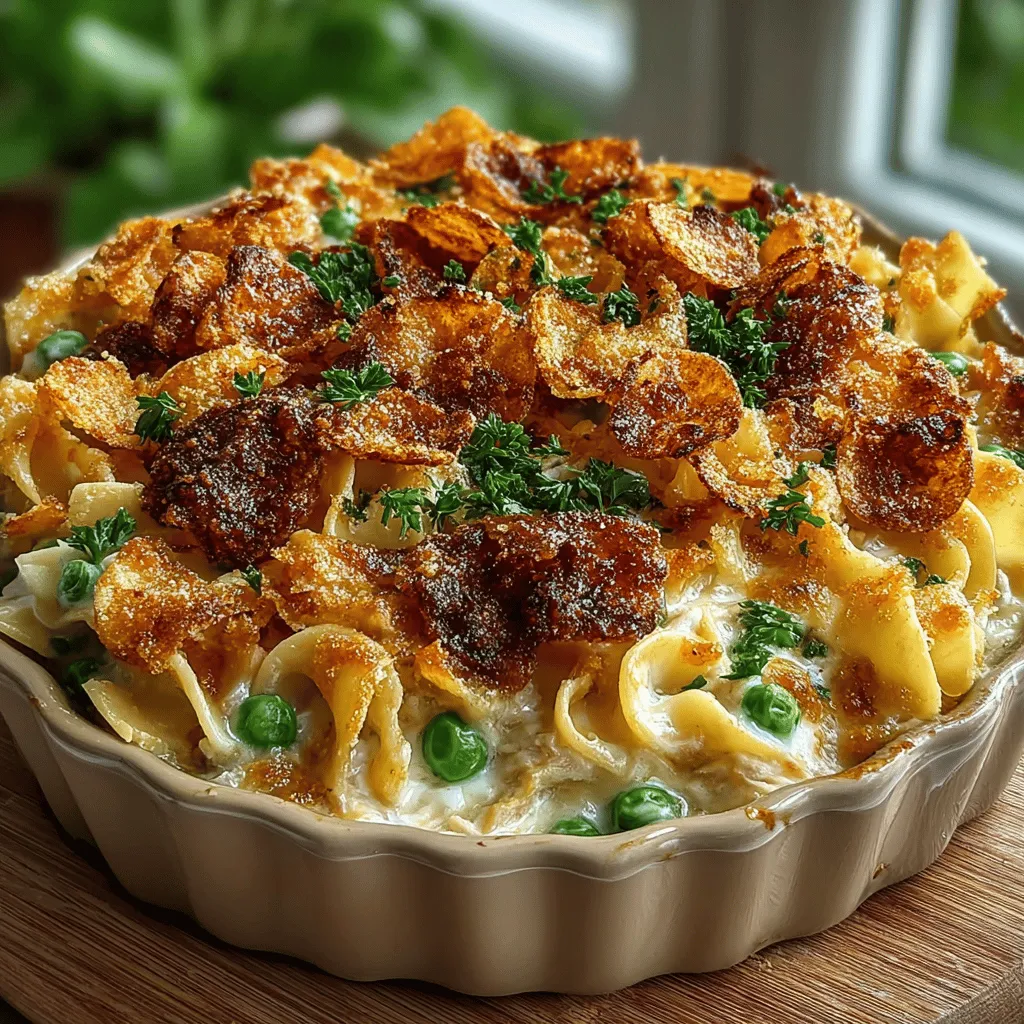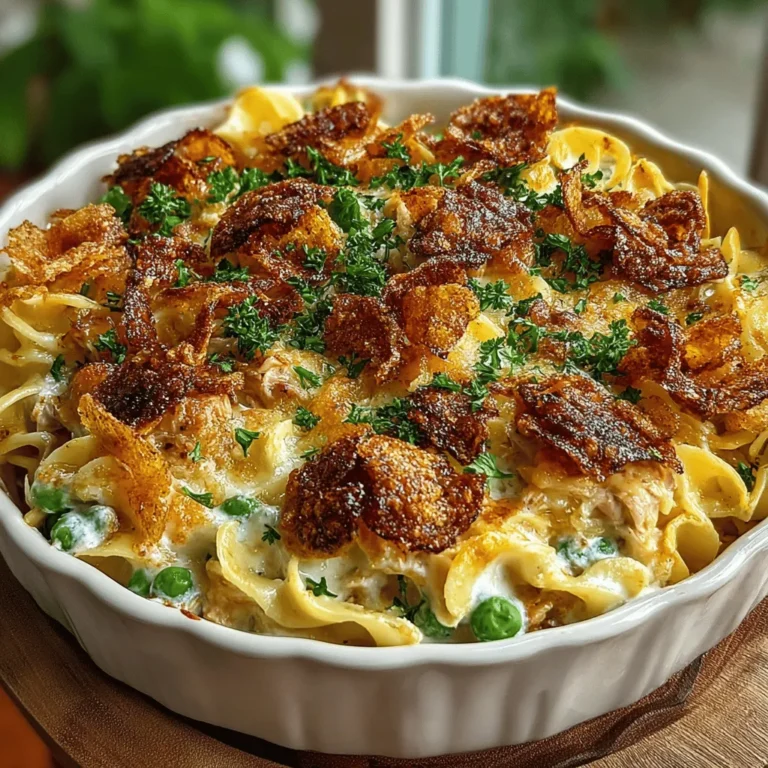Cozy Tuna Noodle Casserole: A Comfort Food Classic
Tuna noodle casserole is a dish that epitomizes comfort food. With its creamy texture, savory flavors, and heartwarming aroma, it has graced dinner tables for decades, often bringing back fond memories of family meals and shared moments. As a quintessential American dish, it checks all the boxes for a quick, satisfying meal that even the pickiest eaters will enjoy. Its simplicity combined with the ability to be customized makes it an enduring favorite for busy weeknights, potlucks, and even casual gatherings.
The nostalgic appeal of tuna noodle casserole is undeniable. Many of us recall our mothers or grandmothers whipping it up with a few pantry staples, transforming modest ingredients into a warm, inviting dish that would fill the kitchen with comforting scents. This familiarity is part of what makes it so special; it’s not just a recipe, but a connection to home, family, and tradition.
Understanding Tuna Noodle Casserole
So, what exactly is tuna noodle casserole? At its core, this dish is a baked casserole that typically features egg noodles, canned tuna, and a creamy sauce, often enhanced with vegetables and topped with a crunchy layer of breadcrumbs or cheese. The history of tuna noodle casserole dates back to the 1950s when it emerged as a budget-friendly meal during a time of economic restraint. It quickly became a staple in American households, celebrated for both its affordability and ease of preparation.
Comfort food plays a significant role in cultures around the world, and tuna noodle casserole is no exception. It represents the quintessential home-cooked meal that brings people together. In addition to its emotional value, this dish is loaded with nutritional benefits. Tuna is an excellent source of lean protein and omega-3 fatty acids, which are essential for heart health. Egg noodles provide carbohydrates for energy, while the addition of vegetables like peas contributes vital vitamins and minerals to the dish.
Key Ingredients
To create the perfect cozy tuna noodle casserole, understanding the key ingredients is crucial:
– Egg Noodles: These soft, chewy noodles are a staple in many casseroles. Their unique texture allows them to hold the sauce well, ensuring that each bite is flavorful. Various types of egg noodles are available, such as wide, medium, or even whole grain, allowing for personal preference and dietary needs.
– Tuna: The choice of tuna significantly impacts the flavor and nutritional value of the casserole. Opting for high-quality tuna, preferably packed in water or olive oil, not only enhances the taste but also ensures you’re getting a healthy dose of protein and beneficial fats.
– Frozen Peas: These little green gems add a pop of color and sweetness to the dish. They are also packed with nutrients, including vitamins A, C, and K, and are a convenient option since they require no additional preparation.
– Sour Cream and Cream of Mushroom Soup: These ingredients play a vital role in creating the creamy texture that makes tuna noodle casserole so comforting. Sour cream adds a slight tang, while cream of mushroom soup contributes a rich, savory flavor that complements the tuna beautifully.
– Sharp Cheddar Cheese: Known for its bold flavor and excellent melting properties, sharp cheddar cheese is often used to top the casserole, creating a deliciously golden crust. Its sharpness balances the creaminess of the other ingredients, providing a complex flavor profile.
– Other Ingredients: Onions and garlic are essential for building a flavor base, while Worcestershire sauce adds a depth of umami. Fresh or dried dill lends a refreshing herbal note, and a variety of seasonings can be adjusted to taste, making the dish versatile and customizable.
Preparation Steps Explained
Now that we’ve covered the essential components of a cozy tuna noodle casserole, let’s dive into the preparation steps.
1. Preheat the Oven: Before you begin assembling your casserole, it’s crucial to preheat your oven to 350°F (175°C). Preheating ensures that your casserole cooks evenly and that the flavors meld beautifully as it bakes.
2. Cook the Egg Noodles: Bring a large pot of salted water to a boil and add your egg noodles. Cook according to the package instructions until they are al dente. This step is essential, as overcooked noodles can become mushy in the casserole.
3. Prepare the Sauce: While the noodles are cooking, you can prepare the creamy sauce. In a large mixing bowl, combine the cream of mushroom soup, sour cream, Worcestershire sauce, and seasonings. Gently stir in the drained tuna and thawed frozen peas, ensuring everything is well mixed.
4. Sauté Aromatics: In a skillet, sauté diced onions and minced garlic until they are translucent and fragrant. This step enhances the overall flavor of your casserole, providing a savory base that complements the tuna and creaminess of the sauce.
5. Combine Ingredients: Once the noodles are cooked and drained, add them to the sauce mixture along with the sautéed onions and garlic. Stir gently to combine all the ingredients, ensuring that the noodles are evenly coated with the creamy sauce.
This initial preparation sets the stage for creating a delicious and satisfying cozy tuna noodle casserole that will warm hearts and bellies alike. In the following sections, we will explore the final assembly, baking instructions, and tips for serving this beloved dish.

Cooking Egg Noodles: Tips for Achieving the Perfect Al Dente Texture
Cooking the egg noodles is a critical step in preparing your cozy tuna noodle casserole. To achieve that perfect al dente texture, start by bringing a large pot of salted water to a rolling boil. The salt not only flavors the noodles, but it also helps in maintaining their firmness. Once the water reaches a boil, add the egg noodles and stir gently to prevent sticking. Cook according to the package instructions, usually around 6-8 minutes, but be sure to check for doneness a minute or two earlier. You want the noodles to be tender yet firm to the bite.
After draining the noodles, rinse them briefly under cold water. This process halts the cooking and prevents them from becoming mushy. Draining thoroughly ensures that excess water doesn’t dilute your casserole mixture later on. Set the noodles aside and let them cool slightly while you prepare the remaining ingredients.
Creating the Casserole Mixture: Importance of Thorough Mixing for Flavor Distribution
The casserole mixture is the heart of your tuna noodle casserole, and thorough mixing is essential for even flavor distribution. Start by combining the canned tuna, which should be well-drained to avoid excess moisture, with your cream of mushroom soup and milk in a large mixing bowl. Using a spatula or wooden spoon, gently fold the ingredients together until they are fully combined.
Next, add your sautéed onions, peas, and seasonings. Be sure to mix thoroughly, scraping the sides of the bowl to ensure every ingredient is uniformly mixed. This step is crucial; it ensures that every bite of the casserole will have a balanced flavor profile, making it a delightful experience for everyone at the table.
Combining Ingredients: Techniques for Folding Noodles Properly
When it’s time to combine the egg noodles with the casserole mixture, use a gentle folding technique to avoid breaking the noodles. Start by adding the cooked noodles into the bowl containing the tuna mixture. Using a large spatula, scoop from the bottom and gently fold the noodles on top of the mixture. Turn the bowl as you fold to ensure even distribution of the sauce and ingredients without mashing the noodles.
Take your time with this step, as properly combined ingredients will result in a cohesive casserole. Once the noodles are folded in, transfer the entire mixture into a greased 9×13 inch baking dish, spreading it evenly for uniform cooking.
Baking the Casserole: Ideal Temperature and Time for Optimal Results
To bake your casserole, preheat your oven to 350°F (175°C). This temperature is ideal for heating the casserole through without burning the top or drying out the noodles. Once the oven reaches the desired temperature, cover the casserole with aluminum foil to prevent it from browning too quickly. Bake for about 25 minutes covered, then remove the foil and allow it to bake for an additional 10-15 minutes, or until it is bubbly and the top is lightly golden.
This two-step baking process helps to lock in moisture while ensuring that the casserole develops a beautiful crust. Keep an eye on it during the last few minutes to prevent over-browning. Once done, remove the casserole from the oven and allow it to cool for a few minutes before serving.
The Role of Toppings
Importance of the Crushed Potato Chips as a Topping
One of the signature elements of a classic tuna noodle casserole is its crunchy topping. Crushed potato chips provide a satisfying texture contrast to the creamy base of the casserole. Their salty flavor complements the richness of the tuna and the cream sauce perfectly, creating a well-rounded dish. For the best results, add the crushed chips during the last 10-15 minutes of baking, ensuring they get crispy without burning.
Alternatives to Potato Chips: Other Options for Crunch and Flavor
If you’re looking for alternatives to potato chips, consider using panko breadcrumbs mixed with a little melted butter for a lighter, yet still crunchy texture. Alternatively, crushed crackers or tortilla chips can also work well for that satisfying crunch. For a healthier option, you might try topping your casserole with toasted nuts or seeds, which can add a delightful flavor and a nutritious twist.
Balancing Textures: The Significance of Having a Crunchy Topping on a Creamy Base
The interplay between the creamy filling and a crunchy topping is what elevates a tuna noodle casserole from good to great. The creamy base, rich with flavors, contrasts beautifully with the crisp topping, providing a delightful textural experience in every bite. This balance makes the casserole not only comforting but also satisfying, making it a family favorite at the dinner table.
Serving Suggestions
Ideal Accompaniments for Tuna Noodle Casserole
When serving your cozy tuna noodle casserole, consider pairing it with a fresh, crisp salad. A simple green salad with mixed greens, cherry tomatoes, and a light vinaigrette can cut through the richness of the casserole. Alternatively, steamed vegetables like broccoli or green beans make for a nutritious side that complements the dish beautifully.
Presentation Ideas for Serving the Dish
For an appealing presentation, consider garnishing the casserole with fresh herbs, such as parsley or chives, just before serving. This adds a pop of color and freshness that brightens the dish. Serve the casserole directly from the baking dish for a homestyle feel, or portion it onto individual plates for a more elegant presentation.
Variations for Dietary Preferences (Gluten-Free, Vegetarian)
If you have guests with dietary restrictions, there are several ways to modify this recipe. For a gluten-free version, substitute the egg noodles with gluten-free pasta and ensure that the cream of mushroom soup is also labeled gluten-free. If you want to make a vegetarian tuna noodle casserole, you can replace the tuna with sautéed mushrooms or chickpeas, adding extra seasoning to keep the flavor profile robust.
Storage and Reheating Tips
Best Practices for Storing Leftover Casserole
If you have any leftovers, store them in an airtight container in the refrigerator. The casserole will keep well for up to 3-4 days. For best results, wait until the casserole has completely cooled before sealing it in a container. This practice helps to prevent moisture buildup, which can lead to sogginess.
How to Properly Reheat Without Losing Texture and Flavor
To reheat the casserole, preheat your oven to 350°F (175°C). Place the casserole in an oven-safe dish and cover it with aluminum foil to retain moisture. Heat for about 20-30 minutes, or until warmed through. If you want to restore some of the original crunch, remove the foil for the last 5-10 minutes of reheating.
Freezing Options and Their Implications on Taste
If you want to freeze the casserole, it’s best to do so before baking. Assemble the casserole in a freezer-safe dish, cover it tightly with plastic wrap and aluminum foil, and store it in the freezer for up to 2-3 months. When you’re ready to bake, thaw it in the refrigerator overnight and then bake as directed. This method preserves the flavor and texture best, allowing you to enjoy a homemade meal on a busy day.
Conclusion
The cozy tuna noodle casserole is a comforting dish that warms the heart and brings families together. Its creamy texture, combined with the crunch of potato chips or other toppings, creates a delightful contrast that is sure to please everyone at the table. Whether you’re serving it for a weeknight dinner or a special occasion, this recipe makes for a wholesome family meal that is easy to prepare and delicious to enjoy.
We encourage you to try this cozy tuna noodle casserole recipe, as it embodies the joy of sharing home-cooked meals with loved ones. As you gather around the table, savor the flavors and the laughter, and make cherished memories that will last a lifetime. Enjoy the comfort and warmth that this dish brings, and don’t hesitate to experiment with variations to make it your own!


